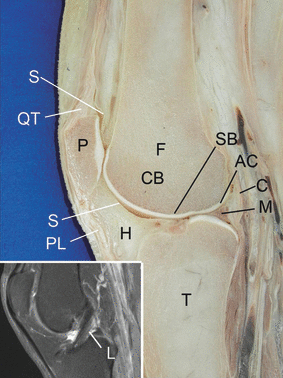The anatomical basis for a novel classification of osteoarthritis and allied disorders
- PMID: 20070426
- PMCID: PMC2829386
- DOI: 10.1111/j.1469-7580.2009.01186.x
The anatomical basis for a novel classification of osteoarthritis and allied disorders
Abstract
Osteoarthritis (OA) has historically been classified as 'primary' where no discernible cause was evident and 'secondary' where a triggering factor was apparent. Irrespective of the triggering events, late-stage OA is usually characterized by articular cartilage attrition and consequently the anatomical basis for disease has been viewed in terms of cartilage. However, the widespread application of magnetic resonance imaging in early OA has confirmed several different anatomical abnormalities within diseased joints. A key observation has been that several types of primary or idiopathic OA show ligament-related pathology at the time of clinical presentation, so these categories of disease are no longer idiopathic - at least from the anatomical perspective. There is also ample evidence for OA initiation in other structures including menisci and bones in addition to articular cartilage. Therefore, a new classification for OA is proposed, which is based on the anatomical sites of earliest discernible joint structural involvement. The major proposed subgroups within this classification are ligament-, cartilage-, bone-, meniscal- and synovial-related, in addition to disease that is mixed pattern or multifocal in origin. We show how such a structural classification for OA provides a useful reference framework for staging the magnitude of disease. For late-stage or end-stage/whole organ disease, the final common pathway of these different scenarios, joint replacement strategies are likely to remain the only viable option. However, for younger subjects in particular, near the time of clinical disease onset, this scheme has implications for therapy targeted to specific anatomical locations. Thus, in the same way that tumours can be classified and staged according to their tissue of origin and extent of involvement, OA can likewise be anatomically classified and staged. This has implications for therapeutic strategies including regenerative medicine therapy development.
Figures




References
-
- Aagaard H, Verdonk R. Function of the normal meniscus and consequences of meniscal resection. Scand J Med Sci Sports. 1999;9:134–140. - PubMed
-
- Adams JG, McAlindon T, Dimasi M, et al. Contribution of meniscal extrusion and cartilage loss to joint space narrowing in osteoarthritis. Clin Radiol. 1999;54:502–506. - PubMed
-
- Agarwala S, Jain D, Joshi VR, et al. Efficacy of alendronate, a bisphosphonate, in the treatment of AVN of the hip. A prospective open-label study. Rheumatology (Oxford) 2005;44:352–359. - PubMed
-
- Anderson DD, Brown TD, Radin EL. The influence of basal cartilage calcification on dynamic juxtaarticular stress transmission. Clin Orthop Relat Res. 1993:298–307. - PubMed
-
- Bellamy N, Kirwan J, Boers M, et al. Recommendations for a core set of outcome measures for future phase III clinical trials in knee, hip, and hand osteoarthritis. Consensus development at OMERACT III. J Rheumatol. 1997;24:799–802. - PubMed
MeSH terms
LinkOut - more resources
Full Text Sources
Medical

